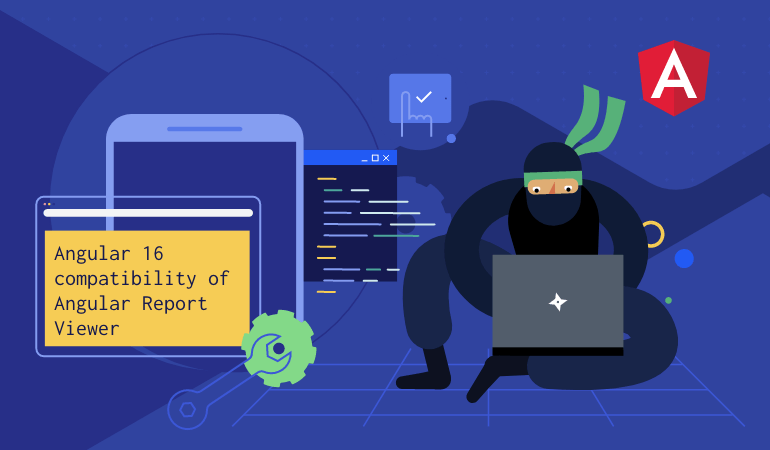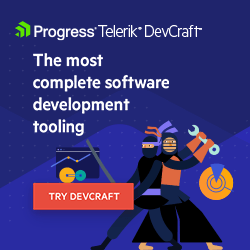Gauge Item in Telerik Reporting, Rules Grouping in Fiddler—Don’t Miss the R2 2023 Release

See what’s new in the R2 2023 release for Telerik Reporting, Telerik Report Server and Telerik Fiddler Everywhere from Progress.
All right, all right, all right! We at Progress Telerik cannot advise you on all life challenges, but we do believe we get data presentation and web troubleshooting. Read on if you’re curious what we managed to introduce in our R2 2023 release for you.
R2 2023 Highlights in Reporting & Fiddler Everywhere
- [Reporting & Report Server] Introduce Gauge report item
- [Reporting & Report Server] Improved ARIA support by accessibility role attribute rendering in HTML5-based report viewers
- [Reporting & Report Server] Exported PDF documents now cover PDF/A-1a accessibility standard
- Support .NET 8 Latest preview (Windows only)
- [Reporting] Angular 16 compatibility of the Angular Report Viewer
- [Reporting] SQL Query Builder and improved assembly resolution in the .NET flavor of the Standalone Report Designer
- [Report Server] Fixes and UX enhancements in Report Server Manager
- [Fiddler] Easily organize your rules and apply bulk actions with the new Rules Grouping functionality
- [Fiddler] Capture and analyze gRPC traffic (in beta) with the latest protocol support added to Fiddler Everywhere
- [Fiddler] Fiddler Everywhere will try to negotiate a higher TLS connection with the newly added support for TLS 1.3 encryption protocol
- [Fiddler] Automatically proxy all requests from cURL, Node.js and Python apps to Fiddler Everywhere through the preconfigured Terminal option
- [Fiddler] Create and add Custom Columns based on Request and Response Headers
- [Fiddler] The new Fiddler-specific page for handling websites with an insecure connection gives you the option to ignore server errors for specific domains only
- [Fiddler] Server certificate information is now available for saved/shared sessions showing the status at the time of capturing
- [Fiddler] Take advantage of the new Offline Support (in beta) in Fiddler Everywhere that allows you to use the app in an isolated environment with limited or no internet access
Webinar is Coming: Progress Telerik Reporting, JustMock and Fiddler Tools R2 2023 Release Webinar | June 12
Before we get into explaining the introduced features in more depth, make sure you save your spot on the dedicated release webinar. No written text can compete with a live presentation and demo, so I encourage you to save a seat and enjoy our host Sam Basu and our product-specific gurus demonstrating most of the goodies we cover today:
Ok, now to the details as promised!
Telerik Reporting & Report Server R2 2023 Details
Support for .NET 8 Latest Preview (Windows Only)

The year advances, and .NET 8 with it. We have you covered so that you can embed Reporting functionality in your .NET 8 (Preview) applications. Yes, the Windows-only limitation should be mentioned here, but stay tuned for our next big release. I believe news is coming.
The REST report service that enables all HTML5-based web report viewers, the Native Blazor Report Viewer, and the desktop report viewers for WPF and WinForms are all compatible with the new framework version. For your convenience, the Telerik Reporting installer deploys a dedicated set of sample projects targeting .NET 8 Preview 4.
Gauge Report Item

Report authors can now easily convey key metrics or performance indicators by using a new Gauge report item. It supports displaying radial gauges. The gauge contains a needle representing the desired value and one or more value ranges represented by arcs. The arcs are defined by their minimum and maximum threshold values and can have different styles. The value of the gauge can be data-bound using an expression. Additionally, all min and max values defining the arcs can also be data-bound. This dynamic and interactive element enables users to quickly assess progress, compare actual values against targets, and identify areas that require attention.
PDF Documents Now Cover PDF/A-1a Accessibility Standard

Accessibility is a must for us because it is a must for you. Based on your valuable feedback, we revisited our export of PDF documents and improved them. In particular, we improved the structure elements and structure tree generation of the generated document. What that means is that each text span and image and drawing in the document belong to a semantic tree so that assistive technologies such as screen readers know it and allow better navigation among the information. Simple.
This means the produced documents now meet the requirements of the PDF/A-1a (“a” for accessibility) standard, and this is what we write as a document as a claim.
Angular 16 Compatibility of the Angular Report Viewer

The Angular Report Viewer in Telerik Reporting received an update in terms of compatibility and now supports the Ivy rendering engine, which is mandatory as of Angular 16. Effectively, users can seamlessly integrate the Angular Report Viewer into their applications built on Angular 13+, ensuring a smooth and consistent user experience. Note that Angular versions prior 13.0.0 are not supported because of this change.
Improved ARIA Support by Accessibility Role Attribute Rendering in HTML5-Based Report Viewers

We improved the ARIA (Accessible Rich Internet Applications) support in Telerik Reporting significantly. On the web, when accessibility is enabled, the rendered report items now contain predefined accessibility roles. This way they conform better to the ARIA standard, bringing a better reporting experience for all users, regardless of their abilities.
The report author can use a dedicated AccessibleRole property on each report item to customize the assigned accessibility role, bringing even more specific content to the users. The assigned value can be a constant string or be data-bound to the item’s data context.
The Table item rendering on the web is now rendered as a hierarchy of elements so that the assistive technologies recognize it as table content and present it with better support for screen readers, keyboard navigation and assistive technologies.
SQL Query Builder and Improved Assembly Resolution in the .NET Flavor of the Standalone Report Designer

Previously, we introduced a .NET 6 build of the comprehensive Standalone Report Designer for authoring reports on a desktop. One important tool that was missing from that tool is the SQL Query Builder enabling mouse-only SQL query composing. We managed to build the necessary dependencies for .NET and introduce this experience for the clients targeting .NET in their applications. The only small limitation is that this version of the Query Builder does not automatically retrieve the relations between the database tables, so JOIN fields should be selected from the respective dropdowns.
The release also brings a quality-of-life improvement in assembly resolution which is set up in the application configuration file. This enhancement simplifies the configuration of resolving and loading extensibility assemblies for the Telerik Reporting report generation engine. The developer can now only use the name of the target extensibility assembly instead of its file name. This streamlined approach not only improves the efficiency of assembly resolution but also provides flexibility in managing dependencies and resolving potential conflicts.
Fixes and UI Enhancements in Report Server Manager
Report Server received numerous fixes and quality-of-life UI changes that improve the overall experience while managing the server assets, and I will list the most significant ones:
- Scheduled Task/Data Alert on-demand execution now does not need the task to be enabled so that the user can use it in manual-only mode.
- User management UI has improved client-side validation when adding permissions to users and roles for a more responsive and easier-to-navigate user experience.
- When creating a new report, the Category dropdown is no more prepopulated as we received feedback that this is error-prone.
- We addressed an issue preventing the web report preview to be triggered from the Standalone Report Designer while designing a server report.
End of Support for Silverlight Report Viewer and WCF Reporting Service
We had to make the decision to end support for the Silverlight Report Viewer and its associated WCF Reporting Service. This strategic move aligns with the industry-wide shift toward modern web technologies and reflects our commitment to providing cutting-edge reporting solutions.
With the discontinuation of support, we encourage you to transition to alternative reporting viewers that leverage newer frameworks such as HTML5 and Blazor. This transition ensures compatibility with current browsers and enables the end users to take advantage of the latest reporting features and performance improvements.
Fiddler Everywhere R2 2023 Details
Rules Grouping
Fiddler Everywhere provides a Rules Grouping functionality that allows easier workflow and better organization of rules based on your scenarios. The feature supports multiple levels—from single rules to groups and subgroups—which you can easily achieve using drag and drop. The improved rules view also lets you apply actions in bulk including enabling, disabling, executing, reordering and more.

Capture gRPC
You can now capture gRPC traffic (in beta) and troubleshoot applications that use this framework out of the box with Fiddler Everywhere. The gRPC traffic will be visualized in the Live Traffic with a specific icon and can be further analyzed in the Trailers tab of the Response body in the Inspectors.

TLS 1.3 Support
Fiddler Everywhere will use by default the higher TLS 1.3 version which is now supported in the app. While establishing the HTTPS connection, if the client and/or the server support TLS 1.3, Fiddler Everywhere will select/suggest it and indicate the version and needed info on multiple places in the app.

Capture Traffic Through Terminal
Fiddler Everywhere now offers one more alternative way for capturing HTTPS traffic without trusting the Fiddler Root Certificate. The latest Terminal option allows you to capture traffic from other locally run cURL, Node.js and Python apps and proxy all requests to Fiddler Everywhere. The supported terminals are:
- On Windows – Command Prompt, Windows PowerShell and PowerShell
- On macOS – Terminal application
- On Linux – GNOME terminal, Konsole, Xterm and X-terminal-emulator

Create Custom Columns
Add custom-made columns to the live traffic grid and set filters to them to ease the traffic inspection process in Fiddler Everywhere:
- Use existing sessions headers – From the Request/Response Headers sections right-click on the headers that you’d want to take out as a separate column.
- Create a new column from scratch – From the Columns dropdown, choose the Add Custom Column button and fill in the relevant information such as Request or Response as a Source, Header Name and Column Title.

Security Improvements
You can also find the following security improvements recently added to Fiddler Everywhere:
- Server certificates information is now available for saved/shared sessions as well and showcases the status of the certificate at the time of capturing the requests.
- A new Fiddler-specific page will be displayed when you try to open a website with an invalid certificate while Fiddler is running. The page informs you that the connection is insecure and gives you the option to ignore server errors for specific domains that you trust.
Offline Support
We are introducing a new offline mode in Fiddler Everywhere that will allow you to use the application in an isolated environment with limited or no internet access. If your setup requires the need of such offline support to perform traffic inspection and debugging analysis, reach out to telerik-sales@progress.com to learn more about the functionality.
Final Words
I appreciate that you made it to this point in the blog post. This means you, just like us, believe in the importance of using the right tools for the right job. I hope you found what you need and will give a try to some or all of our products:

Milen Elkin
Milen Elkin is Product Manager of Telerik Reporting & Telerik Report Server. It’s been a while since he joined the company back in 2007. What drives his work is the belief that handling data should be easy. Besides his work, he likes running and cycling in the city of Sofia and enjoys the countless shapes and shades of green color up in the Bulgarian mountains.


